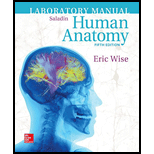
Concept explainers
(a)
To determine:
The muscle used to pull the stalled car.
Introduction:
Muscles of the pectoral girdle are of two types, anterior group muscle and posterior group muscle. The anterior group contains two muscles, pectoralis minor and serratus anterior. The pectoralis minor arises from the 3-5 ribs, while, the serratus anterior arises from most of the ribs. The posterior group contains three deep muscles, the rhomboid minor, the rhomboid major, and levator scapulae.
(b)
To determine:
The muscle used in paddling the canoe.
Introduction:
Muscles of the pectoral girdle are of two types, anterior group muscle and posterior group muscle. The anterior group contains two muscles, pectoralis minor and serratus anterior. The pectoralis minor arises from the 3-5 ribs, while, the serratus anterior arises from most of the ribs. The posterior group contains three deep muscles, the rhomboid minor, the rhomboid major, and levator scapulae.
(c)
To determine:
The muscle that is used in squaring the muscle during military action.
Introduction:
Muscles of the pectoral girdle are of two types, anterior group muscle and posterior group muscle. The anterior group contains two muscles, pectoralis minor and serratus anterior. The pectoralis minor arises from the 3-5 ribs, while, the serratus anterior arises from most of the ribs. The posterior group contains three deep muscles, the rhomboid minor, the rhomboid major, and levator scapulae.
(d)
To determine:
The muscle used to lift the shoulder to carry a heavy box on it.
Introduction:
Muscles of the pectoral girdle are of two types, anterior group muscle and posterior group muscle. The anterior group contains two muscles, pectoralis minor and serratus anterior. The pectoralis minor arises from the 3-5 ribs, while, the serratus anterior arises from most of the ribs. The posterior group contains three deep muscles, the rhomboid minor, the rhomboid major, and levator scapulae.
(e)
To determine:
The muscle used to lower the shoulder to grasp the suitcase.
Introduction:
Muscles of the pectoral girdle are of two types, anterior group muscle and posterior group muscle. The anterior group contains two muscles, pectoralis minor and serratus anterior. The pectoralis minor arises from the 3-5 ribs, while, the serratus anterior arises from most of the ribs. The posterior group contains three deep muscles, the rhomboid minor, the rhomboid major, and levator scapulae.
Want to see the full answer?
Check out a sample textbook solution
Chapter 12 Solutions
Laboratory Manual for Human Anatomy
- Which of the following is not a DNA binding protein? 1. the lac repressor protein 2. the catabolite activated protein 3. the trp repressor protein 4. the flowering locus C protein 5. the flowering locus D protein 6. GAL4 7. all of the above are DNA binding proteinsarrow_forwardWhat symbolic and cultural behaviors are evident in the archaeological record and associated with Neandertals and anatomically modern humans in Europe beginning around 35,000 yBP (during the Upper Paleolithic)?arrow_forwardDescribe three cranial and postcranial features of Neanderthals skeletons that are likely adaptation to the cold climates of Upper Pleistocene Europe and explain how they are adaptations to a cold climate.arrow_forward
- Biology Questionarrow_forward✓ Details Draw a protein that is embedded in a membrane (a transmembrane protein), label the lipid bilayer and the protein. Identify the areas of the lipid bilayer that are hydrophobic and hydrophilic. Draw a membrane with two transporters: a proton pump transporter that uses ATP to generate a proton gradient, and a second transporter that moves glucose by secondary active transport (cartoon-like is ok). It will be important to show protons moving in the correct direction, and that the transporter that is powered by secondary active transport is logically related to the proton pump.arrow_forwarddrawing chemical structure of ATP. please draw in and label whats asked. Thank you.arrow_forward
- Outline the negative feedback loop that allows us to maintain a healthy water concentration in our blood. You may use diagram if you wisharrow_forwardGive examples of fat soluble and non-fat soluble hormonesarrow_forwardJust click view full document and register so you can see the whole document. how do i access this. following from the previous question; https://www.bartleby.com/questions-and-answers/hi-hi-with-this-unit-assessment-psy4406-tp4-report-assessment-material-case-stydu-ms-alecia-moore.-o/5e09906a-5101-4297-a8f7-49449b0bb5a7. on Google this image comes up and i have signed/ payed for the service and unable to access the full document. are you able to copy and past to this response. please see the screenshot from google page. unfortunality its not allowing me attch the image can you please show me the mathmetic calculation/ workout for the reult sectionarrow_forward
 Fundamentals of Sectional Anatomy: An Imaging App...BiologyISBN:9781133960867Author:Denise L. LazoPublisher:Cengage LearningLifetime Physical Fitness & WellnessHealth & NutritionISBN:9781337677509Author:HOEGERPublisher:Cengage
Fundamentals of Sectional Anatomy: An Imaging App...BiologyISBN:9781133960867Author:Denise L. LazoPublisher:Cengage LearningLifetime Physical Fitness & WellnessHealth & NutritionISBN:9781337677509Author:HOEGERPublisher:Cengage Human Physiology: From Cells to Systems (MindTap ...BiologyISBN:9781285866932Author:Lauralee SherwoodPublisher:Cengage Learning
Human Physiology: From Cells to Systems (MindTap ...BiologyISBN:9781285866932Author:Lauralee SherwoodPublisher:Cengage Learning Anatomy & PhysiologyBiologyISBN:9781938168130Author:Kelly A. Young, James A. Wise, Peter DeSaix, Dean H. Kruse, Brandon Poe, Eddie Johnson, Jody E. Johnson, Oksana Korol, J. Gordon Betts, Mark WomblePublisher:OpenStax College
Anatomy & PhysiologyBiologyISBN:9781938168130Author:Kelly A. Young, James A. Wise, Peter DeSaix, Dean H. Kruse, Brandon Poe, Eddie Johnson, Jody E. Johnson, Oksana Korol, J. Gordon Betts, Mark WomblePublisher:OpenStax College





